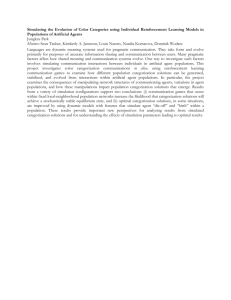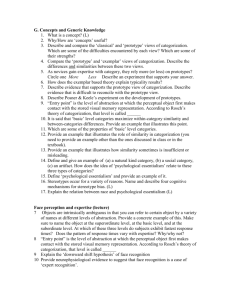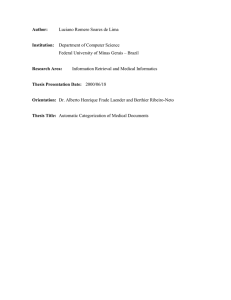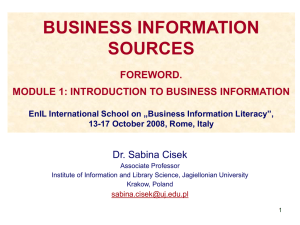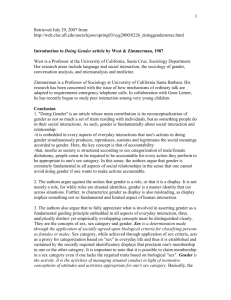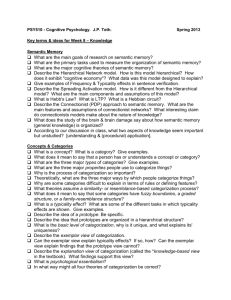Automatic Categorization of Query Results SIGMOD ’04 F. Kaushik Chakrabarti S. Surajit Chaudhuri
advertisement
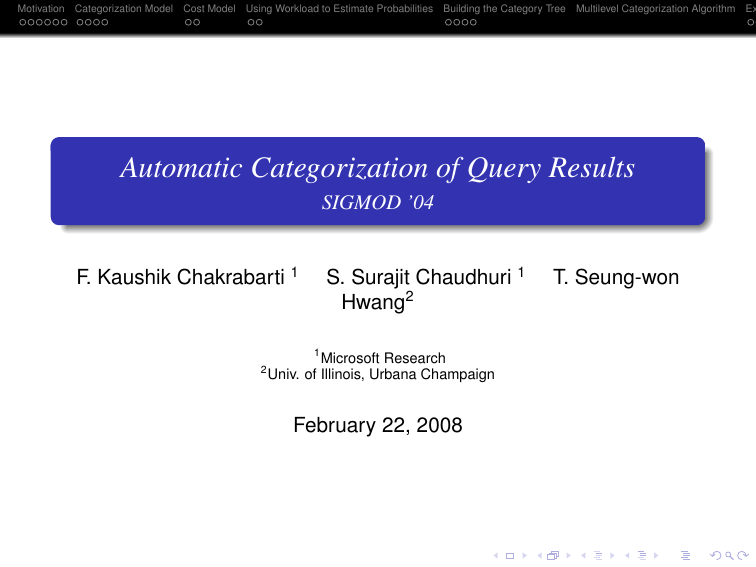
Motivation Categorization Model Cost Model Using Workload to Estimate Probabilities Building the Category Tree Multilevel Categorization Algorithm Ex
Automatic Categorization of Query Results
SIGMOD ’04
F. Kaushik Chakrabarti 1
2
S. Surajit Chaudhuri 1
Hwang2
1
Microsoft Research
Univ. of Illinois, Urbana Champaign
February 22, 2008
T. Seung-won
Motivation Categorization Model Cost Model Using Workload to Estimate Probabilities Building the Category Tree Multilevel Categorization Algorithm Ex
M OTIVATION
Exploratory queries are increasingly becoming a common
phenomenon in database systems.
e.g. search for a book on a given subject on Amazon.com
These queries return too-many results, but only a small fraction
is relevant
the user ends up examining all or most of the result tuples to find
the interesting ones.
Can happen when the user is unsure about what is relevant
e.g.user shopping for a home is often unsure of the exact
neighborhood, price range . . .
This phenomenon is commonly referred to as information-overload
Motivation Categorization Model Cost Model Using Workload to Estimate Probabilities Building the Category Tree Multilevel Categorization Algorithm Ex
M OTIVATION
Exploratory queries are increasingly becoming a common
phenomenon in database systems.
e.g. search for a book on a given subject on Amazon.com
These queries return too-many results, but only a small fraction
is relevant
the user ends up examining all or most of the result tuples to find
the interesting ones.
Can happen when the user is unsure about what is relevant
e.g.user shopping for a home is often unsure of the exact
neighborhood, price range . . .
This phenomenon is commonly referred to as information-overload
Motivation Categorization Model Cost Model Using Workload to Estimate Probabilities Building the Category Tree Multilevel Categorization Algorithm Ex
M OTIVATION
Exploratory queries are increasingly becoming a common
phenomenon in database systems.
e.g. search for a book on a given subject on Amazon.com
These queries return too-many results, but only a small fraction
is relevant
the user ends up examining all or most of the result tuples to find
the interesting ones.
Can happen when the user is unsure about what is relevant
e.g.user shopping for a home is often unsure of the exact
neighborhood, price range . . .
This phenomenon is commonly referred to as information-overload
Motivation Categorization Model Cost Model Using Workload to Estimate Probabilities Building the Category Tree Multilevel Categorization Algorithm Ex
M OTIVATION
Exploratory queries are increasingly becoming a common
phenomenon in database systems.
e.g. search for a book on a given subject on Amazon.com
These queries return too-many results, but only a small fraction
is relevant
the user ends up examining all or most of the result tuples to find
the interesting ones.
Can happen when the user is unsure about what is relevant
e.g.user shopping for a home is often unsure of the exact
neighborhood, price range . . .
This phenomenon is commonly referred to as information-overload
Motivation Categorization Model Cost Model Using Workload to Estimate Probabilities Building the Category Tree Multilevel Categorization Algorithm Ex
C OMMON APPROACHES TO AVOID
INFORMATION - OVERLOAD
from the IR scenario
Ranking
Categorization
Motivation Categorization Model Cost Model Using Workload to Estimate Probabilities Building the Category Tree Multilevel Categorization Algorithm Ex
C OMMON APPROACHES TO AVOID
INFORMATION - OVERLOAD
from the IR scenario
Ranking
Categorization
Motivation Categorization Model Cost Model Using Workload to Estimate Probabilities Building the Category Tree Multilevel Categorization Algorithm Ex
C ATEGORIZATION IN DATABASE SYSTEMS
Category structures are decided in advance.
Categories of a result tuple is decided in advance.
Examples: Amazon, Walmart, e-Bay . . .
Problem: Susceptibility to skew - defeats the purpose of
categorization
User still experiences information-overload.
Motivation Categorization Model Cost Model Using Workload to Estimate Probabilities Building the Category Tree Multilevel Categorization Algorithm Ex
C ATEGORIZATION IN DATABASE SYSTEMS
Category structures are decided in advance.
Categories of a result tuple is decided in advance.
Examples: Amazon, Walmart, e-Bay . . .
Problem: Susceptibility to skew - defeats the purpose of
categorization
User still experiences information-overload.
Motivation Categorization Model Cost Model Using Workload to Estimate Probabilities Building the Category Tree Multilevel Categorization Algorithm Ex
C ATEGORIZATION IN DATABASE SYSTEMS
Category structures are decided in advance.
Categories of a result tuple is decided in advance.
Examples: Amazon, Walmart, e-Bay . . .
Problem: Susceptibility to skew - defeats the purpose of
categorization
User still experiences information-overload.
Motivation Categorization Model Cost Model Using Workload to Estimate Probabilities Building the Category Tree Multilevel Categorization Algorithm Ex
AUTOMATIC C ATEGORIZATION OF Q UERY R ESULTS
based on query results
Previous categorization techniques were query independent - the
category structure were decided apriori.
Solution: Generate the category structure based on the contents
of tuples in the answerset
Ensure “even” distribution of query results across the category
Motivation Categorization Model Cost Model Using Workload to Estimate Probabilities Building the Category Tree Multilevel Categorization Algorithm Ex
AUTOMATIC C ATEGORIZATION OF Q UERY R ESULTS
based on query results
Previous categorization techniques were query independent - the
category structure were decided apriori.
Solution: Generate the category structure based on the contents
of tuples in the answerset
Ensure “even” distribution of query results across the category
Motivation Categorization Model Cost Model Using Workload to Estimate Probabilities Building the Category Tree Multilevel Categorization Algorithm Ex
AUTOMATIC C ATEGORIZATION OF Q UERY R ESULTS
based on query results
Previous categorization techniques were query independent - the
category structure were decided apriori.
Solution: Generate the category structure based on the contents
of tuples in the answerset
Ensure “even” distribution of query results across the category
Motivation Categorization Model Cost Model Using Workload to Estimate Probabilities Building the Category Tree Multilevel Categorization Algorithm Ex
AUTOMATIC C ATEGORIZATION OF Q UERY R ESULTS
E XAMPLE :
Neighborhood Redmond All
Neighborhood Issaquah Price 200­225K
Bedroom 1­2
Actual Homes
Price 225­250K
Bedroom 3­4
Price 250­275K
Actual Homes
Bedroom 5­9
Price . . .
200­275K
Price . . .
275­300K
Neighborhood Seattle 0
1
. . .
2
. . .
Example of hierarchical categorization
Actual Homes
Motivation Categorization Model Cost Model Using Workload to Estimate Probabilities Building the Category Tree Multilevel Categorization Algorithm Ex
TABLE OF C ONTENTS
Categorization basics
Exploration Model - simulating a “typical” user
Cost estimation - probabilistic
Estimating probabilities using workload
Heuristics
Categorization algorithm
Experimental evaluation
Motivation Categorization Model Cost Model Using Workload to Estimate Probabilities Building the Category Tree Multilevel Categorization Algorithm Ex
C ATEGORIZATION M ODEL
S PACE OF CATEGORIZATION
A hierarchical categorization of R is a recursive partitioning of the
tuples in R defined inductively as follows:
Base Case: Given a ALL node containing all tuples in R, partition R
using a single attribute.
Inductive Step: Given a node C at level l - 1, partition (level l) set
of tuples tset(C) using a single attribute for all nodes in for all nodes
at level l - 1 iff C contains more than a “certain” number of tuples.
Associated with each category C is:
tset(C) : Set of tuples contained in a category C.
label(C) :
For categorical attribute A is of the form A ∈ B where B ⊂ domR (A)
For numeric attribute A is of the form a1 ≤ A ≤ B2 where
a1 , a2 ∈ domR (A).
Motivation Categorization Model Cost Model Using Workload to Estimate Probabilities Building the Category Tree Multilevel Categorization Algorithm Ex
C ATEGORIZATION M ODEL
E XPLORATION M ODEL
To generate a particular instance of hierarchical categorization:
At each level l:
Determine the categorizing attribute A for level l
Determine the partition of domain of values of A for tset(C)
Objective: Choose the attribute-partition combination at each level
such that the resulting instance Topt has least possible information
overload on the user.
Motivation Categorization Model Cost Model Using Workload to Estimate Probabilities Building the Category Tree Multilevel Categorization Algorithm Ex
C ATEGORIZATION M ODEL
E XPLORATION M ODEL
To generate a particular instance of hierarchical categorization:
At each level l:
Determine the categorizing attribute A for level l
Determine the partition of domain of values of A for tset(C)
Objective: Choose the attribute-partition combination at each level
such that the resulting instance Topt has least possible information
overload on the user.
Motivation Categorization Model Cost Model Using Workload to Estimate Probabilities Building the Category Tree Multilevel Categorization Algorithm Ex
C ATEGORIZATION M ODEL
E XPLORATION M ODEL : SCENARIOS
Common exploration scenarios:
ALL User explores the result set R until she finds every tuple
t ∈ R relevant to her.
ONE User explores the result set R until she finds one (or few)
tuple(s)
Motivation Categorization Model Cost Model Using Workload to Estimate Probabilities Building the Category Tree Multilevel Categorization Algorithm Ex
C ATEGORIZATION M ODEL
E XPLORATION M ODEL : SCENARIOS
Common exploration scenarios:
ALL User explores the result set R until she finds every tuple
t ∈ R relevant to her.
ONE User explores the result set R until she finds one (or few)
tuple(s)
Motivation Categorization Model Cost Model Using Workload to Estimate Probabilities Building the Category Tree Multilevel Categorization Algorithm Ex
C ATEGORIZATION M ODEL
E XPLORATION M ODEL : ALL
Model of exploration of node C in ALL scenario:
Algorithm 1 Explore C
1: if C is a non-leaf node then
2:
Choose one of the following:
3:
(1) Examine all tuples in tset(C) {Option SHOWTUPLES}
4:
(2) {Option SHOWCAT}
5:
for i = 1; i ≤ n; i + + do
6:
Examine the label of ith subcategory
7:
Choose one of the following
8:
(2.1) Explore Ci
9:
(2.2) Ignore Ci
10:
end for
11: else
12:
Examine all tuples in tset(C)
13: end if
Motivation Categorization Model Cost Model Using Workload to Estimate Probabilities Building the Category Tree Multilevel Categorization Algorithm Ex
C ATEGORIZATION M ODEL
E XPLORATION M ODEL : ALL
Model of exploration of node C in ONE scenario:
Algorithm 2 Explore C
1: if C is a non-leaf node then
2:
Choose one of the following:
3:
(1) Examine tuples in tset(C) till the first relevant tuple found
{Option SHOWTUPLES}
4:
(2){Option SHOWCAT}
5:
for (i = 1; i ≤ n; i + +) do
6:
Examine the label of ith subcategory
7:
Choose one of the following
8:
(2.1) Explore Ci
9:
(2.2) Ignore Ci
10:
if choice = Explore then
11:
break
12:
end if
13:
end for
14:
15:
16:
else
Examine tuples in tset(C) till the first relevant tuple found
17: end if
Motivation Categorization Model Cost Model Using Workload to Estimate Probabilities Building the Category Tree Multilevel Categorization Algorithm Ex
C OST M ODEL
Define cost as the total number of items, both tuples and
category labels, examined by the user.
Minimizing the cost also minimizes the information-overload a
user encounters.
The choices for a given user for a given query is not known
apriori
but the aggregate-knowledge of previous user behavior is known!
Use the previous knowledge to estimate the cost for the average
case.
Motivation Categorization Model Cost Model Using Workload to Estimate Probabilities Building the Category Tree Multilevel Categorization Algorithm Ex
C OST M ODEL
Define cost as the total number of items, both tuples and
category labels, examined by the user.
Minimizing the cost also minimizes the information-overload a
user encounters.
The choices for a given user for a given query is not known
apriori
but the aggregate-knowledge of previous user behavior is known!
Use the previous knowledge to estimate the cost for the average
case.
Motivation Categorization Model Cost Model Using Workload to Estimate Probabilities Building the Category Tree Multilevel Categorization Algorithm Ex
C OST M ODEL
Define cost as the total number of items, both tuples and
category labels, examined by the user.
Minimizing the cost also minimizes the information-overload a
user encounters.
The choices for a given user for a given query is not known
apriori
but the aggregate-knowledge of previous user behavior is known!
Use the previous knowledge to estimate the cost for the average
case.
Motivation Categorization Model Cost Model Using Workload to Estimate Probabilities Building the Category Tree Multilevel Categorization Algorithm Ex
C OST M ODEL
Define cost as the total number of items, both tuples and
category labels, examined by the user.
Minimizing the cost also minimizes the information-overload a
user encounters.
The choices for a given user for a given query is not known
apriori
but the aggregate-knowledge of previous user behavior is known!
Use the previous knowledge to estimate the cost for the average
case.
Motivation Categorization Model Cost Model Using Workload to Estimate Probabilities Building the Category Tree Multilevel Categorization Algorithm Ex
C OST M ODEL
Define cost as the total number of items, both tuples and
category labels, examined by the user.
Minimizing the cost also minimizes the information-overload a
user encounters.
The choices for a given user for a given query is not known
apriori
but the aggregate-knowledge of previous user behavior is known!
Use the previous knowledge to estimate the cost for the average
case.
Motivation Categorization Model Cost Model Using Workload to Estimate Probabilities Building the Category Tree Multilevel Categorization Algorithm Ex
C OST M ODEL
P ROBABILITIES
Re-define cost as the total number of items, on average,both
tuples and category labels, examined by the user
The user choices in either exploration model are
non-deterministic and not equally likely.
This uncertainty and preference is captured by the following two
probabilities
Exploration Probability P(C): Probability that the user explores
category C, using either SHOWCAT or SHOWTUPLES.
SHOWTUPLES Probability Pw (C): Probability that the user goes
for the option SHOWTUPLES, given that she explores C.
Pw (C) = 1 for a leaf category.
(1 − Pw (C)) is the probability that the user goes for the SHOWCAT
option given that she explores C.
Motivation Categorization Model Cost Model Using Workload to Estimate Probabilities Building the Category Tree Multilevel Categorization Algorithm Ex
C OST M ODEL
P ROBABILITIES
Re-define cost as the total number of items, on average,both
tuples and category labels, examined by the user
The user choices in either exploration model are
non-deterministic and not equally likely.
This uncertainty and preference is captured by the following two
probabilities
Exploration Probability P(C): Probability that the user explores
category C, using either SHOWCAT or SHOWTUPLES.
SHOWTUPLES Probability Pw (C): Probability that the user goes
for the option SHOWTUPLES, given that she explores C.
Pw (C) = 1 for a leaf category.
(1 − Pw (C)) is the probability that the user goes for the SHOWCAT
option given that she explores C.
Motivation Categorization Model Cost Model Using Workload to Estimate Probabilities Building the Category Tree Multilevel Categorization Algorithm Ex
C OST M ODEL
P ROBABILITIES
Re-define cost as the total number of items, on average,both
tuples and category labels, examined by the user
The user choices in either exploration model are
non-deterministic and not equally likely.
This uncertainty and preference is captured by the following two
probabilities
Exploration Probability P(C): Probability that the user explores
category C, using either SHOWCAT or SHOWTUPLES.
SHOWTUPLES Probability Pw (C): Probability that the user goes
for the option SHOWTUPLES, given that she explores C.
Pw (C) = 1 for a leaf category.
(1 − Pw (C)) is the probability that the user goes for the SHOWCAT
option given that she explores C.
Motivation Categorization Model Cost Model Using Workload to Estimate Probabilities Building the Category Tree Multilevel Categorization Algorithm Ex
C OST M ODEL
P ROBABILITIES
Re-define cost as the total number of items, on average,both
tuples and category labels, examined by the user
The user choices in either exploration model are
non-deterministic and not equally likely.
This uncertainty and preference is captured by the following two
probabilities
Exploration Probability P(C): Probability that the user explores
category C, using either SHOWCAT or SHOWTUPLES.
SHOWTUPLES Probability Pw (C): Probability that the user goes
for the option SHOWTUPLES, given that she explores C.
Pw (C) = 1 for a leaf category.
(1 − Pw (C)) is the probability that the user goes for the SHOWCAT
option given that she explores C.
Motivation Categorization Model Cost Model Using Workload to Estimate Probabilities Building the Category Tree Multilevel Categorization Algorithm Ex
C OST M ODEL
P ROBABILITIES
Re-define cost as the total number of items, on average,both
tuples and category labels, examined by the user
The user choices in either exploration model are
non-deterministic and not equally likely.
This uncertainty and preference is captured by the following two
probabilities
Exploration Probability P(C): Probability that the user explores
category C, using either SHOWCAT or SHOWTUPLES.
SHOWTUPLES Probability Pw (C): Probability that the user goes
for the option SHOWTUPLES, given that she explores C.
Pw (C) = 1 for a leaf category.
(1 − Pw (C)) is the probability that the user goes for the SHOWCAT
option given that she explores C.
Motivation Categorization Model Cost Model Using Workload to Estimate Probabilities Building the Category Tree Multilevel Categorization Algorithm Ex
C OST M ODEL
P ROBABILITIES
Re-define cost as the total number of items, on average,both
tuples and category labels, examined by the user
The user choices in either exploration model are
non-deterministic and not equally likely.
This uncertainty and preference is captured by the following two
probabilities
Exploration Probability P(C): Probability that the user explores
category C, using either SHOWCAT or SHOWTUPLES.
SHOWTUPLES Probability Pw (C): Probability that the user goes
for the option SHOWTUPLES, given that she explores C.
Pw (C) = 1 for a leaf category.
(1 − Pw (C)) is the probability that the user goes for the SHOWCAT
option given that she explores C.
Motivation Categorization Model Cost Model Using Workload to Estimate Probabilities Building the Category Tree Multilevel Categorization Algorithm Ex
C OST M ODEL
C OST :A LL
For the ALL scenario,
For a given node a user chooses to explore, she user can either:
execute SHOWTUPLES with cost : Pw (C) × |tset(C)|
execute a SHOWCAT with
P|Ccost:
|
(1 − Pw (C)) × [|Ct | + i=1t P(Ci ) × CostAll (Ci )]
CostAll (C) = Pw (C) × |tset(C)| + (1 − Pw (C)) × [|Ct | +
where Ct is the set of sub-categories of C
P|Ct |
i=1
P(Ci ) × Cos
Motivation Categorization Model Cost Model Using Workload to Estimate Probabilities Building the Category Tree Multilevel Categorization Algorithm Ex
C OST M ODEL
C OST :ONE
For the ONE scenario,
For a given node a user chooses to explore, she user can either:
1
2
3
4
execute SHOWTUPLES with cost : Pw (C) × frac(C) × |tset(C)|
examine some(i) category labels until the relevant label is found and
then explore that category further.
The probability that Ci is the first category explored
Q
( i−1
(1 − P(Cj )) × P(Ci )
j
The cost of exploring Ci = |Ct | + CostAll (Ci )])
CostOne (C) =
P
PQ
i = 1|Ct |P(Ci )
w (C) × frac(C) × |tset(C)| + (1 − Pw (C)) ×
( i−1
(1 − P(Cj )) × P(Ci ) × [|Ct | + CostAll (Ci )])
j
where Ct is the set of sub-categories of C and, frac(C) is the
fraction of tuples the user needs to examine before finding the first
relevant tuple
Motivation Categorization Model Cost Model Using Workload to Estimate Probabilities Building the Category Tree Multilevel Categorization Algorithm Ex
U SING W ORKLOAD TO E STIMATE P ROBABILITIES
P(C) and Pw (C) are needed for the CostOne (T ) and CostAll (T )
Use aggregate knowledge of previous user behavior
Specifically, infer user behavior from the queries executed
previously by users of a given application - DBMS query Log
Motivation Categorization Model Cost Model Using Workload to Estimate Probabilities Building the Category Tree Multilevel Categorization Algorithm Ex
U SING W ORKLOAD TO E STIMATE P ROBABILITIES
C OMPUTING SHOWTUPLES P ROBABILITY
Intuition :
A user does a SHOWTUPLES on a category C, if the user is
interested in all or most values of C, or If a user is interested in only a
few results (or sub-categories) of C, then she chooses the SHOWCAT
option.
Wi : Workload Query
CA : The categorizing attribute of C.
N : total number queries in query log
If Wi has a selection condition on CA , then user is interested in a
few categories of A.
NAttr (CA )
: the probability that the user executes SHOWCAT
N
1−NAttr (CA )
: Pw (C), the probability that the user executes
N
SHOWTUPLES.
Motivation Categorization Model Cost Model Using Workload to Estimate Probabilities Building the Category Tree Multilevel Categorization Algorithm Ex
U SING W ORKLOAD TO E STIMATE P ROBABILITIES
C OMPUTING SHOWTUPLES P ROBABILITY
Intuition :
A user does a SHOWTUPLES on a category C, if the user is
interested in all or most values of C, or If a user is interested in only a
few results (or sub-categories) of C, then she chooses the SHOWCAT
option.
Wi : Workload Query
CA : The categorizing attribute of C.
N : total number queries in query log
If Wi has a selection condition on CA , then user is interested in a
few categories of A.
NAttr (CA )
: the probability that the user executes SHOWCAT
N
1−NAttr (CA )
: Pw (C), the probability that the user executes
N
SHOWTUPLES.
Motivation Categorization Model Cost Model Using Workload to Estimate Probabilities Building the Category Tree Multilevel Categorization Algorithm Ex
U SING W ORKLOAD TO E STIMATE P ROBABILITIES
C OMPUTING SHOWTUPLES P ROBABILITY
Intuition :
A user does a SHOWTUPLES on a category C, if the user is
interested in all or most values of C, or If a user is interested in only a
few results (or sub-categories) of C, then she chooses the SHOWCAT
option.
Wi : Workload Query
CA : The categorizing attribute of C.
N : total number queries in query log
If Wi has a selection condition on CA , then user is interested in a
few categories of A.
NAttr (CA )
: the probability that the user executes SHOWCAT
N
1−NAttr (CA )
: Pw (C), the probability that the user executes
N
SHOWTUPLES.
Motivation Categorization Model Cost Model Using Workload to Estimate Probabilities Building the Category Tree Multilevel Categorization Algorithm Ex
U SING W ORKLOAD TO E STIMATE P ROBABILITIES
C OMPUTING SHOWTUPLES P ROBABILITY
Intuition :
A user does a SHOWTUPLES on a category C, if the user is
interested in all or most values of C, or If a user is interested in only a
few results (or sub-categories) of C, then she chooses the SHOWCAT
option.
Wi : Workload Query
CA : The categorizing attribute of C.
N : total number queries in query log
If Wi has a selection condition on CA , then user is interested in a
few categories of A.
NAttr (CA )
: the probability that the user executes SHOWCAT
N
1−NAttr (CA )
: Pw (C), the probability that the user executes
N
SHOWTUPLES.
Motivation Categorization Model Cost Model Using Workload to Estimate Probabilities Building the Category Tree Multilevel Categorization Algorithm Ex
U SING W ORKLOAD TO E STIMATE P ROBABILITIES
C OMPUTING SHOWTUPLES P ROBABILITY
Intuition :
A user does a SHOWTUPLES on a category C, if the user is
interested in all or most values of C, or If a user is interested in only a
few results (or sub-categories) of C, then she chooses the SHOWCAT
option.
Wi : Workload Query
CA : The categorizing attribute of C.
N : total number queries in query log
If Wi has a selection condition on CA , then user is interested in a
few categories of A.
NAttr (CA )
: the probability that the user executes SHOWCAT
N
1−NAttr (CA )
: Pw (C), the probability that the user executes
N
SHOWTUPLES.
Motivation Categorization Model Cost Model Using Workload to Estimate Probabilities Building the Category Tree Multilevel Categorization Algorithm Ex
U SING W ORKLOAD TO E STIMATE P ROBABILITIES
C OMPUTING SHOWTUPLES P ROBABILITY
Intuition :
A user does a SHOWTUPLES on a category C, if the user is
interested in all or most values of C, or If a user is interested in only a
few results (or sub-categories) of C, then she chooses the SHOWCAT
option.
Wi : Workload Query
CA : The categorizing attribute of C.
N : total number queries in query log
If Wi has a selection condition on CA , then user is interested in a
few categories of A.
NAttr (CA )
: the probability that the user executes SHOWCAT
N
1−NAttr (CA )
: Pw (C), the probability that the user executes
N
SHOWTUPLES.
Motivation Categorization Model Cost Model Using Workload to Estimate Probabilities Building the Category Tree Multilevel Categorization Algorithm Ex
U SING W ORKLOAD TO E STIMATE P ROBABILITIES
C OMPUTING E XPLORATION P ROBABILITY
P(C), probability that the user explores a category C, either by
SHOWCAT or SHOWTUPLES
= P(User explores C | User examines the label of C)
= P(User explores C) ÷ P(User examines the label of C)
= P(User explores C) ÷ P(User explores parent(C) and User examines the label of parent(C))
= P(User explores C) ÷ (P(User explores parent(C)) × P(User chooses SHOWCAT for parent(C) | User explores parent(C)))
Now,
P(User chooses SHOWCAT for parent(C) | User explores parent(C)) = NAttr (parent(CA )) ÷ N
P(User explores C) ÷ P(User explores parent(C)) = P(User interested in label of C)
Noverlap (C)
P(User interested in label of C) =
N
N
(parent(C))
P(C) = P(User interested in label of C) ( Attr
)
N
P(C) =
Noverlap (C)
NAttr (parent(C)A )
Motivation Categorization Model Cost Model Using Workload to Estimate Probabilities Building the Category Tree Multilevel Categorization Algorithm Ex
U SING W ORKLOAD TO E STIMATE P ROBABILITIES
C OMPUTING E XPLORATION P ROBABILITY
P(C), probability that the user explores a category C, either by
SHOWCAT or SHOWTUPLES
= P(User explores C | User examines the label of C)
= P(User explores C) ÷ P(User examines the label of C)
= P(User explores C) ÷ P(User explores parent(C) and User examines the label of parent(C))
= P(User explores C) ÷ (P(User explores parent(C)) × P(User chooses SHOWCAT for parent(C) | User explores parent(C)))
Now,
P(User chooses SHOWCAT for parent(C) | User explores parent(C)) = NAttr (parent(CA )) ÷ N
P(User explores C) ÷ P(User explores parent(C)) = P(User interested in label of C)
Noverlap (C)
P(User interested in label of C) =
N
N
(parent(C))
P(C) = P(User interested in label of C) ( Attr
)
N
P(C) =
Noverlap (C)
NAttr (parent(C)A )
Motivation Categorization Model Cost Model Using Workload to Estimate Probabilities Building the Category Tree Multilevel Categorization Algorithm Ex
U SING W ORKLOAD TO E STIMATE P ROBABILITIES
C OMPUTING E XPLORATION P ROBABILITY
P(C), probability that the user explores a category C, either by
SHOWCAT or SHOWTUPLES
= P(User explores C | User examines the label of C)
= P(User explores C) ÷ P(User examines the label of C)
= P(User explores C) ÷ P(User explores parent(C) and User examines the label of parent(C))
= P(User explores C) ÷ (P(User explores parent(C)) × P(User chooses SHOWCAT for parent(C) | User explores parent(C)))
Now,
P(User chooses SHOWCAT for parent(C) | User explores parent(C)) = NAttr (parent(CA )) ÷ N
P(User explores C) ÷ P(User explores parent(C)) = P(User interested in label of C)
Noverlap (C)
P(User interested in label of C) =
N
N
(parent(C))
P(C) = P(User interested in label of C) ( Attr
)
N
P(C) =
Noverlap (C)
NAttr (parent(C)A )
Motivation Categorization Model Cost Model Using Workload to Estimate Probabilities Building the Category Tree Multilevel Categorization Algorithm Ex
B UILDING THE C ATEGORY T REE
Naive Algorithm:
Enumerate all possible category trees and the CostAll (T ) for
each Tree T .
Choose the tree Topt with the minimum cost
Exponential, in |A| × |CA |!
Apply heuristics to
Eliminate “uninteresting” attributes.
For every remaining attribute, obtain a “good” partitioning instead
of enumerate all possible partitioning
Level-wise partitioning - at each step choose the attribute and its
partitioning that has the least cost.
Motivation Categorization Model Cost Model Using Workload to Estimate Probabilities Building the Category Tree Multilevel Categorization Algorithm Ex
B UILDING THE C ATEGORY T REE
Naive Algorithm:
Enumerate all possible category trees and the CostAll (T ) for
each Tree T .
Choose the tree Topt with the minimum cost
Exponential, in |A| × |CA |!
Apply heuristics to
Eliminate “uninteresting” attributes.
For every remaining attribute, obtain a “good” partitioning instead
of enumerate all possible partitioning
Level-wise partitioning - at each step choose the attribute and its
partitioning that has the least cost.
Motivation Categorization Model Cost Model Using Workload to Estimate Probabilities Building the Category Tree Multilevel Categorization Algorithm Ex
B UILDING THE C ATEGORY T REE
Naive Algorithm:
Enumerate all possible category trees and the CostAll (T ) for
each Tree T .
Choose the tree Topt with the minimum cost
Exponential, in |A| × |CA |!
Apply heuristics to
Eliminate “uninteresting” attributes.
For every remaining attribute, obtain a “good” partitioning instead
of enumerate all possible partitioning
Level-wise partitioning - at each step choose the attribute and its
partitioning that has the least cost.
Motivation Categorization Model Cost Model Using Workload to Estimate Probabilities Building the Category Tree Multilevel Categorization Algorithm Ex
B UILDING THE C ATEGORY T REE
R EDUCING CHOICES OF CATEGORIZING ATTRIBUTES
Presence of a selection condition on an attribute reflects user’s
interest in that attribute.
Eliminate an attribute if it occurs infrequently in the workload
queries i.e. NAttrN(CA ) ≤ Xthreshold ,
Motivation Categorization Model Cost Model Using Workload to Estimate Probabilities Building the Category Tree Multilevel Categorization Algorithm Ex
B UILDING THE C ATEGORY T REE
R EDUCING CHOICES OF CATEGORIZING ATTRIBUTES
Presence of a selection condition on an attribute reflects user’s
interest in that attribute.
Eliminate an attribute if it occurs infrequently in the workload
queries i.e. NAttrN(CA ) ≤ Xthreshold ,
Motivation Categorization Model Cost Model Using Workload to Estimate Probabilities Building the Category Tree Multilevel Categorization Algorithm Ex
B UILDING THE C ATEGORY T REE
PARTITIONING FOR CATEGORICAL ATTRIBUTES
For a query Q that contains a selection condition of the form: “A in
v1 , v2 , ...., vk ” :
v1 , v2 , ...., vk are potential categories
Consider only single-value partitioning
For single-value partitioning, only the presentation order (for
categories) matters.
CostAll (T ) is not affected by the order.
So, minimize for only CostOne (T )
T HEOREM
CostOne (T ) is minimum when the categories are presented to the
1
+CostOne (Ci )
user in increasing order of P(C
i)
Heuristic: CostOne (Ci ) as a constant (drop it)
The categories are presented in decreasing order of Noverlap (Ci ), or
occ(vi )
Motivation Categorization Model Cost Model Using Workload to Estimate Probabilities Building the Category Tree Multilevel Categorization Algorithm Ex
B UILDING THE C ATEGORY T REE
PARTITIONING FOR CATEGORICAL ATTRIBUTES
For a query Q that contains a selection condition of the form: “A in
v1 , v2 , ...., vk ” :
v1 , v2 , ...., vk are potential categories
Consider only single-value partitioning
For single-value partitioning, only the presentation order (for
categories) matters.
CostAll (T ) is not affected by the order.
So, minimize for only CostOne (T )
T HEOREM
CostOne (T ) is minimum when the categories are presented to the
1
+CostOne (Ci )
user in increasing order of P(C
i)
Heuristic: CostOne (Ci ) as a constant (drop it)
The categories are presented in decreasing order of Noverlap (Ci ), or
occ(vi )
Motivation Categorization Model Cost Model Using Workload to Estimate Probabilities Building the Category Tree Multilevel Categorization Algorithm Ex
B UILDING THE C ATEGORY T REE
PARTITIONING FOR N UMERIC ATTRIBUTES
Let Vmin and Vmax be the minimum and maximum values that the
tuples in R can take in attribute A.
Consider a point v (Vmin < v < Vmax ):
If a significant number of query ranges in the workload begin or
end at v, it is a good point to split as the workload suggests that
most users would be interested in just one bucket,
If none of them begin or end at v, hence v is not a good point to
split, if we partition the range into m-buckets then (m-1) points
should be selected where queries begin or end splitpoints.
the other factor is the number of tuples in each bucket.
Define a goodness score, as SUM(startv , endv ), where
startv is the number of query ranges in the workload starting at v
endv is the number of query ranges in the workload ending at v
Precomute the goodness score for all potential split-points.
Motivation Categorization Model Cost Model Using Workload to Estimate Probabilities Building the Category Tree Multilevel Categorization Algorithm Ex
B UILDING THE C ATEGORY T REE
PARTITIONING FOR N UMERIC ATTRIBUTES
Let Vmin and Vmax be the minimum and maximum values that the
tuples in R can take in attribute A.
Consider a point v (Vmin < v < Vmax ):
If a significant number of query ranges in the workload begin or
end at v, it is a good point to split as the workload suggests that
most users would be interested in just one bucket,
If none of them begin or end at v, hence v is not a good point to
split, if we partition the range into m-buckets then (m-1) points
should be selected where queries begin or end splitpoints.
the other factor is the number of tuples in each bucket.
Define a goodness score, as SUM(startv , endv ), where
startv is the number of query ranges in the workload starting at v
endv is the number of query ranges in the workload ending at v
Precomute the goodness score for all potential split-points.
Motivation Categorization Model Cost Model Using Workload to Estimate Probabilities Building the Category Tree Multilevel Categorization Algorithm Ex
B UILDING THE C ATEGORY T REE
PARTITIONING FOR N UMERIC ATTRIBUTES
Motivation Categorization Model Cost Model Using Workload to Estimate Probabilities Building the Category Tree Multilevel Categorization Algorithm Ex
B UILDING THE C ATEGORY T REE
M ULTILEVEL C ATEGORIZATION
Greedy Algorithm:
1
2
3
4
5
For multilevel categorization, for each level l, determine the
categorizing attribute A and for each category C in level (l-1),
partition the domain of values of A in tset(C) such that the
information overload is minimized.
The algorithm creates the categories level by level all categories
at level (l-1) are created and added to tree T before any category
at level l. S denote the set of categories at level (l-1) with more
than M tuples.
For each such candidate attribute A, we partition each category
C in S using the partitioning for Categorical Attributes and
Numerical attributes.
Compute the cost of the attribute-partitioning combination for
each candidate attribute A and select the attribute A with the
minimum cost. For each category C in S, we add the partitions of
C based on A to T.
This Completes the node creation at level l.
Motivation Categorization Model Cost Model Using Workload to Estimate Probabilities Building the Category Tree Multilevel Categorization Algorithm Ex
B UILDING THE C ATEGORY T REE
M ULTILEVEL C ATEGORIZATION
Motivation Categorization Model Cost Model Using Workload to Estimate Probabilities Building the Category Tree Multilevel Categorization Algorithm Ex
E XPERIMENTAL E VALUATION
Empirical studies to:
Evaluate the accuracy of the the cost-model
Comparision of the cost-based categorization model and
compare it “other” models
Motivation Categorization Model Cost Model Using Workload to Estimate Probabilities Building the Category Tree Multilevel Categorization Algorithm Ex
E XPERIMENTAL E VALUATION
M ETHODOLOGY
Dataset
A single ListProperty table, with about 1.7m tuples
Attributes include Location, price, year-built,square-footage . . .
Workload : Over 176,000 query strings representing searches on
the “MSN House and Home” web-site.
Comparision Models
No Cost Categorization attribute and partitioning selected
arbitrarily.
Attr-Cost Attribute selection is cost-based but partitioning is
arbitrary.
Motivation Categorization Model Cost Model Using Workload to Estimate Probabilities Building the Category Tree Multilevel Categorization Algorithm Ex
E XPERIMENTAL E VALUATION
R ESULTS
Motivation Categorization Model Cost Model Using Workload to Estimate Probabilities Building the Category Tree Multilevel Categorization Algorithm Ex
E XPERIMENTAL E VALUATION
C ONCLUSION
Accurate Categorization model
Better Categorization Algorithm

